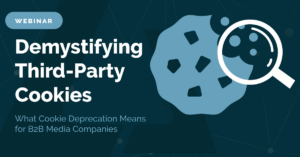We have all heard how crucial first-party data is to marketers, but very often the term itself lacks definition and clarity. “First-party” data has become fairly generalized to mean any data that a company collects about its customers and prospects. At the outset, that seems like a reasonable definition. When one starts to dig deeper, different types of first-party data start to emerge. These layers all have different value and associated use cases so understanding each type and how to activate them will add tremendous depth to your first-party data strategy.
Anonymous first-party data – Sometimes best characterized as clickstream and behavior-based data associated with a tracking cookie. Because there isn’t a specific “known” person behind this data doesn’t mean it doesn’t have marketing value. This type of first-party data is most often used for bottom-of-funnel advertising tactics like site retargeting. In the wild, the best example is a stalking banner or product carousel that follows you around the web after a very recent visit to an e-commerce site. A pretty effective tactic for getting someone to complete a cart check-out process, but a blunt instrument for gaining general interest.
Known first-party data – Sometimes called CRM data because this type of data is typically gained through a customer relationship. Transactional and purchasing details, contact information, preferences, behaviors, and other “declared” data that further explains the person and their relationship with your brand more fall into this high-value category.
First-party data is considered highly reliable because of its very nature, coming solely from one-to-one relationships with customers and prospects, both known and unknown. One of the leading technology investments being made by marketers today is the Customer Data Platform (CDP) which gives marketers the ability to marry all their disparate customer data pools together and connect online behavior. This powerful capability fueled by first-party data is re-inventing the way brand marketers’ campaign.
The CDP does some critically important functions necessary to activate rich first-party data stores.
Reconciliation: Now that the definition of unknown and known first-party data is clear, the ability to bring the two types together (or keep them definitively apart) relies on the reconciliation of identity. Identity is a complex thing as every individual has multiple aspects (cookies, device IDs, IP address, email and more) that contribute to the unique ways a person can be recognized. All CDPs have the ability to reconcile identity, but many do it significantly differently.
Segmentation: Segmentation first-party data is limited only by your tools and your imagination. To enable the broadest array of tactics, the CDP is the preferred technology workhorse because of its key capabilities around online and offline data management, segmentation and activation. With all customer data, known and unknown, living in this environment, it is the natural place to build audience segments for use in marketing programs.
Activation: What good is having all this beautiful first-party data if you can’t connect it to the marketing channel? All CDP’s should connect to the key primary channels of social, digital, email and owned domains. The levels to which the CDP powers marketing activities also vary from platform to platform, but the CDP is where the “rubber meets the road” for marketing activation.
First-party data empowers tactics from the top to the bottom of funnel. Let’s start at the top.
Building highly effective look-alike audiences for acquisition is a stellar tactic at the top of funnel. Whether used in the walled gardens or as fodder for digital advertising onboarding, the use of first-party data to build highly targeted look-alike models can drive huge improvements in Return on Advertising Spend and effectiveness.
Personalization and customization are powered exclusively by data and can drive X factor conversion improvements. Most CDP’s have tools on deck to create more personalized experiences on-site and off – not just a “nice to have” but a consumer expectation in today’s world. Providing mid-funnel content/purchase recommendations and other tailored engagement tactics drive performance.
Retention and loyalty are areas where first-party data is a requirement. Imagine recommending products that just don’t fit your customers’ needs. How many of us have received a “personalization fail” that not only soured your perception of your favorite brand but also left you feeling weird? Leveraging your first-party data the right way can build more loyal and lasting relationships with your customers that translate into higher lifetime value.
Peeling back the layers of first-party data value can reveal dramatic improvements across the customer journey and in all outcomes. It’s not easy but it’s necessary. For brand marketers who are seeing third-party data effectiveness sour, first-party data strategy is crucial and timely. The effort required to create a first-party data strategy is well worth the investment.















